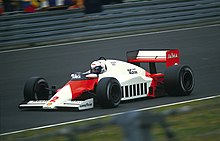John Barnard
John Barnard (born May 4, 1946 in Wembley , England ) is an English engineer and developer of racing cars and motorcycles.
Life
Beginnings in motorsport
Barnard received his engineering degree from Watford College of Technology in Watford (England) and initially worked in industry as a developer of machines for the production of light bulbs. In 1968 he applied to Lola , was hired and was subsequently involved in the development of racing cars for the Vee and SuperVee formulas , the Lola sports car for the American CanAm series and various other projects. At Lola he met the future chief engineer of Williams Grand Prix Engineering , Patrick Head . The two became friends, and Head was the best man at Barnard's wedding.
formula 1
In 1972 Barnard switched to McLaren , where he and Gordon Coppuck developed the cars for the IndyCar championship, Formula 5000 and Formula 1 . With the McLaren M23 won Emerson Fittipaldi in 1974 , the Formula 1 World Championship .
In 1975, Barnard was hired by Parnelli Jones to work alongside Maurice Philippe to design a Formula 1 car that was used from 1974 to 1976 . After Parnelli's retirement from Formula 1, Barnard built a car for him for the IndyCar championship. This is how Jim Hall became aware of Barnard. For his team, Barnard designed the Chaparral 2K , with which Johnny Rutherford won the Indianapolis 500 in 1980 and took the Indycar title.
Ron Dennis brought Barnard to his Project Four Racing team in the early 1980s , for whom he developed a revolutionary composite racing car manufactured by Hercules Aerospace . When Project Four Racing and McLaren merged, this car became the McLaren MP4 / 1 , the technical basis of a number of successful McLaren racing cars. In 1983 Barnard introduced the so-called "bottle neck shape", in which the side pods converge narrowly between the rear wheels, a design that can still be seen in Formula 1 today. Barnard's McLaren won the drivers' championship in 1984 , 1985 and 1986 and achieved 31 race victories
In 1987 Ferrari recruited Barnard, who was at the time the best Formula 1 engineer, and set up a development center for him in England, the Guildford Technical Office (GTO), because Barnard refused to work in Italy . In the GTO, the revolutionary semi-automatic transmission was created, whose first race in the Ferrari 640 Nigel Mansell won in Brazil in 1989 and which shortly afterwards and which has become the standard in all Formula 1 racing cars to this day.
At the end of 1990 , after a season with five race victories with Ferrari, but again without a title, Barnard switched to Benetton and built the Benetton Advanced Research Group in Godalming . There he developed the Benetton B191 , with which Nelson Piquet won a race in 1991 and which was the basis of the B194 , which won the world title in 1994 .
After Barnard fell out with the management of Benetton and worked briefly on a Formula 1 project for Toyota , Ferrari, which had not won a race in the three years since Barnard's departure, offered him the post of Head of Development again in mid-1993. It was the Ferrari Design and Development Engineering Center in Shalford , Surrey , and Gerhard Berger took in 1994 with the 412T1B a victory at the Grand Prix of Germany .
In 1996 , Ferrari underwent major restructuring with the departure of Berger and Alesi and the relocation of development activities to Maranello initiated by Jean Todt . Barnard refused to move to Italy and was replaced by Rory Byrne and Ross Brawn . Barnard bought the Shalford development center in 1997, renamed it B3 Technologies and worked for Arrows . After a dispute with Tom Walkinshaw , the Arrows boss at the time, Barnard switched to the Prost team and, after its bankruptcy in 2002, to Kenny Roberts sr. KR Team entered the MotoGP class of the motorcycle world championship , where he developed racing motorcycles as chief engineer .
In March 2008, Barnard sold its stake in B3 Technologies to a consortium led by former commercial director John Minett.
literature
- Nick Skeens: The Perfect Car: The story of John Barnard, Formula 1's most creative designer . Evro Publishing, London 2018. ISBN 978-1-910505-27-4 .
Web links
| personal data | |
|---|---|
| SURNAME | Barnard, John |
| BRIEF DESCRIPTION | English engineer and developer of racing cars and motorcycles |
| DATE OF BIRTH | May 4, 1946 |
| PLACE OF BIRTH | Wembley , England |


